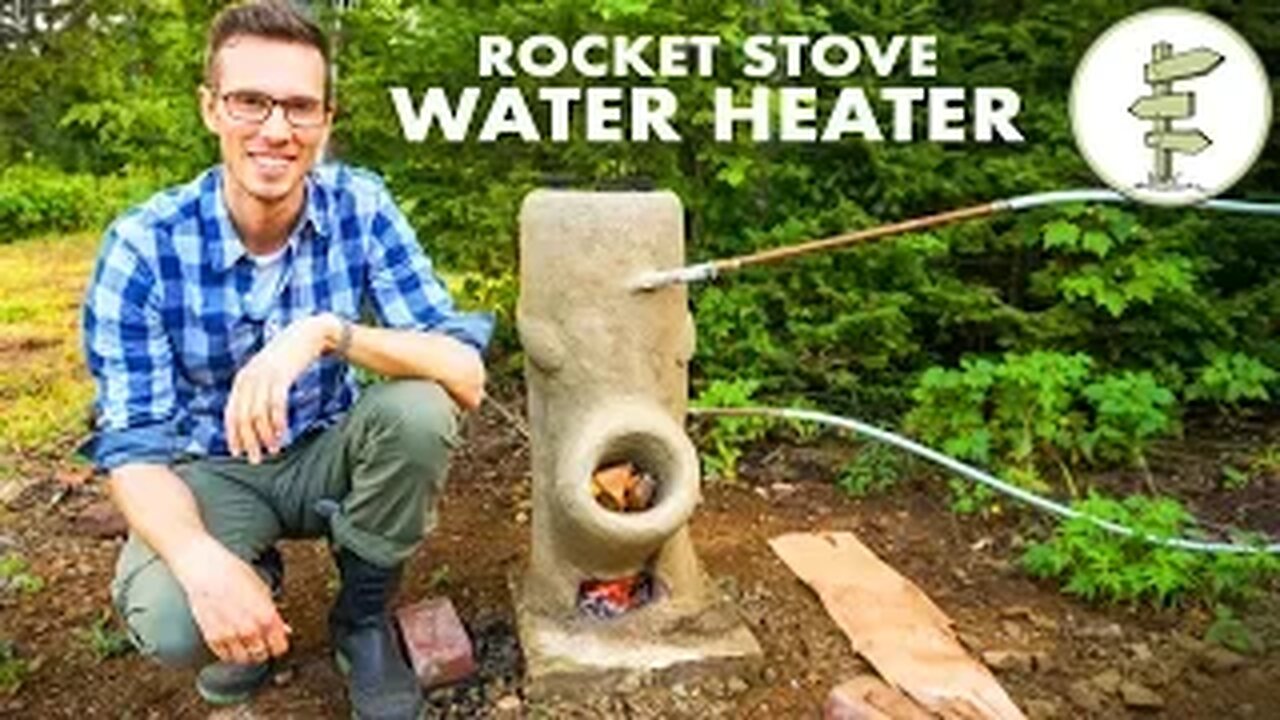Premium Only Content

Brilliant DIY Off-Grid Water Heater Using a Rocket Stove – No Propane!
To create an off-grid water heater using a clay rocket stove, you build a heat exchanger by coiling copper tubing within the stove's insulated clay chimney. As a fire burns in the stove, it heats the copper tubing, which in turn heats the water inside.
The system operates on the principle of thermosiphon, which naturally circulates water without a pump.
Materials and components
Clay/cob mixture: For building the stove body. Cob is a mixture of clay, sand, and straw.
Copper tubing: A 1/2-inch soft copper tubing is ideal for its heat conductivity and flexibility for coiling.
Water storage barrel: An elevated barrel or tank to hold the cold water supply.
Insulation material: Use cob, hay, or glass bottles to insulate the stove base and retain heat.
Stove forms: Use items like PVC pipe, buckets, and cardboard to shape the internal combustion and chimney chambers.
Connecting hoses: For linking the copper coil to the water barrel.
Safety equipment: A thermometer for checking water temperature and a steam relief valve for safety.
How to build the system
Prepare the clay: Mix your clay, sand, and straw to form a durable cob mixture.
The right consistency is crucial for creating the structure.
Build the stove base: Create a stable, insulated foundation for your stove. Lay down a base layer of cob and place materials like glass bottles or corrugated iron underneath to prevent ground moisture from wicking up.
Construct the rocket stove: Form the classic "J" shape of the rocket stove from your cob mixture, using forms to shape the combustion chamber, fuel feed, and insulated vertical chimney (heat riser).
Install the heat exchanger:
While building the vertical chimney, wrap the soft copper tubing in a tight coil around the chimney section. Leave the inlet and outlet ends extending outside the clay structure. Use sand to fill the tubing during bending to prevent kinking.
Add thermal mass: Cover the coiled copper tubing with more clay and insulation.
This thermal mass will absorb and radiate heat, keeping the water warm for a while even after the fire is out.
Connect the system:
Place your water storage barrel higher than the stove to facilitate thermosiphon.
Connect the copper coil's lower end to the bottom of the water barrel.
Connect the copper coil's upper end to the top of the barrel.
Test the system:
Start a small fire in the rocket stove's fuel chamber.
As the water in the copper coil heats, it will rise back into the barrel, drawing colder water into the coil from the bottom in a continuous cycle.
Monitor the water temperature with a thermometer to ensure it reaches a safe level.
How the thermosiphon principle works
Thermosiphon is a passive heat exchange method based on natural convection, which means it requires no mechanical pump.
Water is heated: The water inside the copper coils is heated by the high-temperature fire in the rocket stove's chimney.
Water rises: Hot water is less dense and rises out of the top of the coil, back into the elevated storage barrel.
Cold water sinks: Simultaneously, denser cold water from the bottom of the barrel is drawn into the bottom of the copper coil.
Continuous cycle: This natural cycle continues as long as the fire is burning, heating the entire volume of water in the barrel.
Pros and cons of a clay rocket stove water heater
Aspect Pros Cons
Energy source Uses wood, a renewable and easily accessible resource. Requires constant tending and feeding of wood to maintain heat.
Fuel efficiency Burns wood very efficiently and cleanly, producing minimal smoke. Can be less efficient than a traditional wood stove for heating large water volumes.
Circulation Operates without electricity using the thermosiphon effect. Requires careful design and placement of the water barrel relative to the stove.
Material cost Uses inexpensive materials like clay, sand, and straw. Copper tubing can be a significant cost.
Heating speed Heats water relatively quickly for its size.
May still take a couple of hours to heat a large barrel of water.
Versatility Can function as both a cooktop and water heater.
Not a practical solution for heating large buildings or large, continuous volumes of water.
Complexity Simple to build for DIYers with basic knowledge.
Requires skill to properly design and build the rocket stove and heat exchanger for maximum efficiency.
Modeling of a Heating System equipped with a
Biomeiler and a Heat Pump
Exploring Alternatives
-
 LIVE
LIVE
Badlands Media
10 hours agoDEFCON ZERQ Ep. 018
19,536 watching -
 2:05:03
2:05:03
Inverted World Live
5 hours agoHouse Votes to Release Epstein Files w/ Emilie Hagen & Denise Bovee | Ep. 143
49.5K2 -
 3:02:27
3:02:27
TimcastIRL
5 hours agoEpstein Transparency PASSED UNANIMOUSLY, Trump To SIGN Release | Timcast IRL
225K109 -
 6:26:43
6:26:43
SpartakusLIVE
6 hours agoARC is SO ADDICTING - I just CAN'T stop || NEW SCHEDULE, NEED SLEEP
73.7K -
 LIVE
LIVE
Drew Hernandez
22 hours agoEPSTEIN TRANSPARENCY ACT PASSES: POLITICAL THEATER OR FULL DISCLOSURE?
1,110 watching -
 LIVE
LIVE
StevieTLIVE
5 hours ago#1 SOLO Warzone POV 6.9 KD
115 watching -
 2:57:53
2:57:53
Barry Cunningham
9 hours agoBREAKING NEWS: PRESIDENT TRUMP HOSTS DINNER WITH SAUDI ARABIA CROWN PRINCE MOHAMMED BIN SOLMAN !
71.6K27 -
 LIVE
LIVE
Spartan
4 hours agoPro Halo Player, insta locking Neon, plays Valorant for the first time since Beta. Rusty af on MnK
467 watching -
 30:14
30:14
Robbi On The Record
11 days ago $8.92 earnedYou’re Out of Alignment: Spiritually, Mentally, Physically. Here’s Why. ft Dr. Rich
67.6K5 -
 57:56
57:56
Sarah Westall
4 hours agoFormer DIA Chief of Global Operations: CIA and FBI - Broad Institutional Crisis w/ Jeffrey Prather
28.7K2